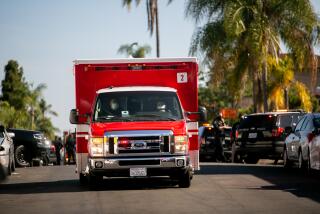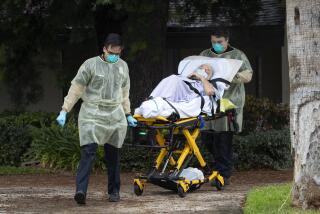Doctors Decry âNeglected Epidemicâ of Trauma Deaths
Against a backdrop of mangled metal from long-ago car crashes, four doctors Thursday said the lack of emergency room trauma centers across the nation is contributing to the unnecessary deaths of about 24,000 accident and crime victims each year.
âIf you are injured at 11 oâclock tonight, and youâre unconscious and in shock, somebodyâs got to make that decision of how and where to treat you. In most of California, that decision isnât madeâ with sufficient care and skill, said Dr. Donald Trunkey, chief of surgery at San Francisco General Hospital.
Trunkey and the other doctors, along with fire and law enforcement officials, called for the establishment of trauma care systems throughout the nation at a press conference held--to underscore their point--in an Anaheim automobile salvage yard on the first day of a national trauma care conference in Anaheim. More than 500 physicians, nurses, paramedics and other emergency response officials are attending the Modern Concepts in Trauma Care symposium at the Anaheim Hilton.
Trauma--severe injury sustained through automobile accidents, shootings, stabbings and falls--is the number one killer of people in their prime, yet many of those deaths are preventable if the medical and hospital communities establish trauma care systems, said Trunkey, who is chairman of the American College of Surgeonsâ committee on trauma.
âItâs the neglected epidemic of modern society,â said Dr. John West, a surgeon affiliated with St. Joseph Hospital, Orange, and the course director of the national 0trauma care symposium.
In a trauma care system, certain hospital emergency rooms are designated âtrauma centersâ and are specially equipped and staffed around the clock by physicians, nurses and technicians experienced in treating such injuries. Paramedics, directed to take severely injured patients to the designated trauma centers by a central communications network, may pass other hospital emergency rooms on the way in order to get the patients to the specialized facilities.
Orange Countyâs trauma system is nearly five years old, and new systems have been started in Los Angeles and San Diego counties. Elsewhere in the state, only San Francisco and Sacramento have trauma systems, according to authorities at the press conference.
In Orange County, preventable deaths have dropped from 71% to 9% since the trauma system was established, said West, who was the systemâs chief architect in 1980.
In San Francisco, one out of five auto crash victims deemed dead at the scene are brought back to life by trauma surgeons who open up the chest and start the heart pumping again, Trunkey said.
âThatâs how powerful a trauma center can be,â Trunkey said.
Of the trauma victims who die, the majority succumb to internal bleeding during the first hour, often called the âgolden hour,â said Dr. Howard Champion, chief of trauma service at Washington Hospital Center in Washington, D.C.
âSometimes itâs a golden 10 minutes,â Champion said. âThe big bang for the buck is early treatment.â
Yet, if a trauma patient is brought to a non-trauma center for treatment, often there is no surgeon in the hospital, special life-saving equipment is not immediately available and labs are not open to handle the case, the doctors said.
A 1966 report pointed out shortcomings in trauma care, and a just-released National Research Council âwhite paperâ titled âInjury in America: A Continuing Health Problemâ determined that âlittle has been done since 1966,â Trunkey said.
Using the hood of a crunched-up yellow Ford Fairmont station wagon as a black board, Trunkey scratched out the basics of trauma care and its statistics:
- Of the trauma victims who die, about half succumb in the first half-hour. âThereâs nothing we can do about that . . . except prevention,â for example, wearing seat belts and not driving drunk, Trunkey said. In states with mandatory seat belt laws, traffic deaths have have declined by 27%, he said. The fact that California has no such law âis an indictment against our legislative system,â he said.
Pointing to the mangled car behind him, Trunkey said the occupants would have had an 80% better chance of surviving the accident if there had been air bags installed.
- Thirty percent die one to three hours later, primarily of internal bleeding and blood clots in the brain, he said.
- Twenty percent die one to three weeks later of infections, Trunkey said.
The last two categories are âwhere trauma centers are important,â he said. The hospital with a trauma center makes a commitment to the severely injured that goes beyond the emergency room, and should even include rehabilitation so that the trauma patient fully recovers from the injuries and is able to return to the work force, he said.
âA patient dies because of the weakest link in the system,â said Champion, who added that hospitals with trauma centers must have continually restocked blood banks, 24-hour laboratories and other support facilities.
Plenty of Candidates
Yet across the state and the nation, communities do not have trauma systems because of âapathetic medical communities and greedy hospital communities,â West said.
When a trauma system is started, too often too many hospitals want to be designated, eager for the high visibility and extra patients, West said. Whatâs more, he added, the hospitals in the wealthier parts of cities arrange boundaries so that an inner-city hospital gets a disproportionate number of stabbing and shooting cases--often involving uninsured patients.
âThe answer is good county planning,â West said.
It is important to not have too many designated trauma centers in a community because they are expensive to operate, and each appointed hospital must be confident there will be sufficient patients to support the specialized services, Champion said. In addition, trauma physicians need a steady volume of patients to keep their skills honed, an important element because they must have experience to work rapidly and expertly, he said.
âIf too many get designated, it makes it less cost-effective . . . and that weakens the system overall,â said West.
Los Angeles County has 21 trauma centers, and the system probably should have no more than 15, he said.
Call for State Subsidization
It is difficult to make trauma centers cost-effective in rural areas because there is insufficient population, Trunkey said. He called for state subsidization of rural trauma centers, suggesting that a $5 fee on driversâ license renewal could finance the cost. Even though people from non-rural areas would be paying the fee, they would reap the benefits if they were injured while traveling in the rural communities, he said.
Warning on Some Centers
West warned against hospitals with âself-designatedâ trauma centers. Unless a community has an organized system, hospitals that claim they have trauma centers cannot be required to meet standards for care and are not open to independent review, he said.
âThey simply put up a sign. They canât be providing the same kind of quality care as a designated trauma center,â West said.
Larry McBride, training officer for the state fire marshalâs office and for the Citrus Heights Fire Department, said firefighters must be specially trained to quickly extricate crash victims, because the âgolden hourâ starts ticking away at the time of the collision.
All too often firefighters will stand around and wait for a modern hydraulic prying tool to open up a crunched car, when they could use hand tools, such as a hammer and screwdriver, to gain access to the injured victim, he said.
Chief Robert Rengstorff, representing the California Highway Patrol commissionerâs office, said that 400 lives have been saved during the past three years because of helicopters used to transport victims. In addition, about 1,000 of the stateâs 4,500 patrol officers are trained emergency medical technicians, he said.
West said that while $1,000 is spent on research for every cardiac victim, $1 is spent on research per trauma victim.
Autopsies are not performed on half the trauma victims even though they provide information on how well emergency rooms and trauma centers are performing, he said.
âWe wonder if they are not hiding something,â West said, referring to the non-autopsied trauma victims as âburied sinsâ and âgrave errors.â
More to Read
Sign up for Essential California
The most important California stories and recommendations in your inbox every morning.
You may occasionally receive promotional content from the Los Angeles Times.










